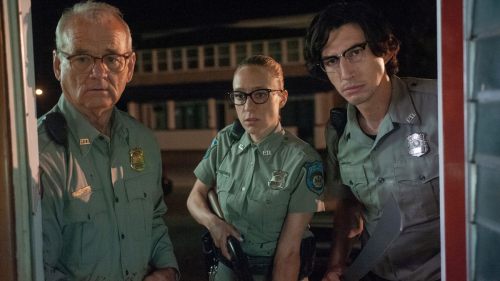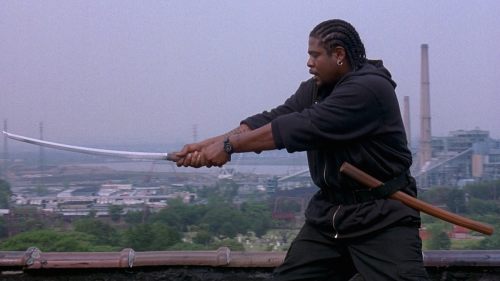A Note on Vampire Electronics
Only Lovers Left Alive (Devin’s review) was one of the regrettably many smaller films I missed seeing in a theater in 2014, but thankfully it’s one that Ma Redbox has allowed me to catch up with this year. And when I finally got the chance to sit down with it, boy was I charmed! This lovely, quiet little film from director Jim Jarmusch brings a wonderfully fresh spin to the otherwise played-out vampire genre.
Spoilers follow, so beware if you haven’t seen the film (and go see it!). The picture introduces us to titular lovers Adam (Tom Hiddleston) and Eve (Tilda Swinton), who are hundreds of years into both their marriage and their vampirehoods. They’re past the sexy, ravenous stage of bloodsucking immortality, and they’ve settled into a comfortable routine of amusing themselves with artistic and intellectual pursuits and each other’s company. Theirs is, in some ways, a model for a mature coupling: loving, accepting of each other’s eccentricities and not afraid to give the other space where space is needed. Oddly enough, it’s one of the healthier marriages I’ve seen on screen since Coach and Tami Taylor* took a bow.
While Eve has occupied herself with botany and literature, Adam’s primary interest has been music. He’s been an underground composer for years, feeding the occasional adagio to Schubert, and is now a consummate musical historian and shadowy rock legend. Unsurprisingly, given the inherently mathematical nature of music, Adam has also been an avid student of science in his long years. He holds Pythagoras, Galileo, Copernicus and Newton in his pantheon of scientific heroes, and he evinces a particular affinity for Tesla. When he’s not composing, he spends his spare time tinkering, at one point cobbling together a FaceTime client with an old Dell notebook and a castoff CRT television.
DIY Facetime
Given this premise, as a film fan, I’m sold on Only Lovers Left Alive. And then a moment happens about a third of the way through the picture that really tickles my science bone. Since I help cover that beat around here, I want to delve into it in a little bit of detail.
Ruminating on his heroes earlier in the film, Adam laments: “Tesla, destroyed. His beautiful possibilities completely ignored." He’s referring, of course, to Serbian inventor Nikola Tesla and some of the more forward-thinking projects he was rumored to have taken on, including wireless power beaming and death rays. Later, as he and Eve are going through his vinyl collection in his dilapidated, off-the-grid Detroit home, the power goes out, and Eve follows him into the garden to discover the source of the problem. His backyard power generator has given out, and as Eve begins to probe him on the source of his home’s power, the following interchange ensues:
Eve: "What a hidden treasure! My darling, did you make this?"
Adam: "Well, I cobbled it together from bits and pieces."
Eve: "It’s beautiful! You're an alchemist! Wow!"
Adam: "I just need to check the charges and the connections. This might need a recalibration."
Eve: "Are these the antennae?"
Adam: "Yeah. They're receiving electrical information from the atmosphere."
Eve: "From outer space?"
Adam: "They get converted into energy by this dynamo here. Hang on, let me just see this."
Backyard "dynamo"
So, it seems that while taking breaks from his genius-level composition work, Adam has gone and fulfilled Tesla’s dreams of wireless power transfer in his spare time - no big deal.
Since I’m professionally interested in this sort of thing and prone to over-analysis, I began reflecting a bit more on what it is that Adam’s actually doing here. Is this “from the atmosphere” power coming from the sun or from deep space, as Eve intuits? Is it coming from a more pedestrian source like cell phone signals and FM radio? And how’s he getting enough of it to keep his old Victorian mansion running?
To begin, it helps to know a little more about the concept of wireless power transfer, which has been knocking around for a little more than a century at this point. As the name suggests, wireless power transfer involves getting power from one place to another without using wires. One location will have a source of power and a transmitter for sending the power, and another location will have a receiver and a way of either using the power directly or storing it for later use.
Adam’s hero Tesla was indeed one of the first serious proponents of and experimenters in the field. Tesla used a technique called inductive coupling to illuminate lightbulbs across a stage at the storied 1893 Columbian Exposition in Chicago. He was later able to extend the feat to lighting bulbs outside his laboratory during his years working in his Colorado Springs lab (familiar, perhaps, from Christopher Nolan’s film, The Prestige). Inductive coupling makes use of the magnetic part of electromagnetic fields, literally “coupling” a receiver to a transmitter so that power is only sent from the transmitter if a receiver is present**. Inductive coupling is an effective enough technique, and it’s still commonly used in wireless toothbrush chargers and starting to see more widespread use in wireless chargers for smart phones. It has big limitations, though, since it operates in the electromagnetic near field and the transmitter can never be very far from the receiver. Tesla thought he had a way to overcome these restrictions, and he worked these concepts into plans for a “World Wireless System”. He began building the first transmitter in this system in 1901 on Long Island in the town of Shoreham, New York, with the backing of legendary financier J.P. Morgan. Tesla, though, had sold the project to Morgan as a communication system only, intended to compete with the rival radio communication work being done by Italian Guglielmo Marconi at the time. The ink on their agreement was barely dry before Tesla began lobbying Moran for supplemental funds to extend the project to power transfer. Morgan would never agree to the extension, and the work on the so-called Wardenclyffe Tower was abandoned in 1906 without any demonstration of Tesla’s long-range power transfer claims. It’s generally held today that Tesla’s ideas would not be able to extend out to the ranges he posited, due to their inherently near field nature, but Tesla stubbornly claimed otherwise until his death.
Tesla’s Wardenclyffe Tower on Long Island (image courtesy Wikipedia)
So, is the film suggesting that Adam, using loads of spare time and his centuries-old vampire 401-k, found some way around these problems? Perhaps, given his affinity for Tesla’s work, the inventor’s ideas form the basis for Adam’s experiments, but Adam seems to have taken things a step further. Whereas Adam is quite proudly off the grid, Tesla wanted to be the grid. His World Wireless System would have consisted of a network of thirty stations, and the wireless links between transmitter stations and receiver stations would have taken the place of today’s long-distance transmission lines. Transmitter stations would have been co-located with conventional power plants, much as the grid hooks up to power stations today.
Adam tells us he’s built a station to receive “electrical information from the atmosphere,” so that raises the question: where is his power coming from? It’s doubtful that lone wolf Adam is a customer of a Vampire World Wireless System with its own transmitting stations, so it appears that, rather than receiving power generated for his use, Adam is instead harvesting power from the atmosphere around him. That’s a far trickier thing to do.
It should come as no shock that there’s loads of waste radio frequency (RF) energy in the atmosphere around us all the time, with our modern love of broadcast television and radio, mobile phone networks and Wi-Fi, among other common RF sources. Since we’ve already generated and used power to launch that energy into the atmosphere, it would be great if we could find a way to pull the part of it that’s not being received by actual radios back out, over time, and use it to power other devices. That’s very hard to do in practice, though. The RF energy we use to communicate is pretty minuscule once it travels the distance from transmitter to receiver. Since things like Wi-Fi or cell phone radios have their own power supplies, we’re not relying on the RF energy they receive to actually power them. Rather, those radios just need to figure out if there’s a signal there at all, and then they need to be able to tell the difference between the real signal and atmospheric noise after a bunch of fancy math. To do this, they actually use their own battery power to boost that signal up to a level where the fancy math has a better chance of working, so in essence this is the exact opposite of what we’d like to do with ambient RF power harvesting. The good news for our smartphone addictions is that this works pretty well even when the amount of received RF power is low, which in practice it nearly always is (since RF strength decays quite quickly as it travels away from its source). The bad news for our RF power harvesting ambitions is that this power is usually always small enough that it’s very difficult to do anything useful with it if we can figure out a way to collect it.
So, has Adam cracked the nut on harvesting TV and cell phone signals from the atmosphere? Perhaps, but recall that Eve observes that his generator is taking power “from outer space,” a notion which he doesn’t disabuse. Clearly, the most efficient power plant in our immediate neighborhood is the Sun, which constantly bathes the Earth in energetic radiation. Add to that the dim radiation we receive from more distant stars and energy still rattling around from the birth of the Universe, and it’s clear that there’s a lot out there to be exploited. So are we to assume that’s where Adam is getting his juice?
Ground-based solar cells are just a way, here on Earth, to take advantage of some of that radiation hitting Earth’s surface. You probably remember from high school science that visible light only forms a small part of the radiation from the sun, though. So, has Adam found a way to harvest a wider swath of the Sun’s radiation spectrum?
We see from the image below that Earth’s atmosphere does a pretty good job of filtering out most of the radiation coming at the planet. That’s a good thing up in the high frequency bands where Gamma and X-rays live, since that kind of radiation tends to cause cancer and other nasty side effects when we’re exposed to too much of it. Most of what hits the ground is visible light and radio waves. Since Adam doesn’t seem to be relying on solar cells, we can only assume that, if he’s harnessing energy from space, it’s from the radio spectrum. Now, as difficult as it is to vacuum useful RF energy from terrestrial sources, even when we’re swimming in the stuff, imagine how hard it would be to scoop up usable radio signals that have been decaying over the vast distances they’ve traveled from the sun or other stars!
How Earth’s atmosphere filters out radiation. (image courtesy NASA, Wikipedia)
So what is Adam’s “dynamo”*** actually doing? Narratively, of course, it’s meant to evoke the outsider chic of Nikola Tesla and bestow a little of that on our protagonist. Scientifically, it doesn’t really matter, since Only Lovers Left Alive isn’t asking us to take it seriously on that level like, say, Christopher Nolan’s Interstellar. Lovers is really more a “science-adjacent” film in that regard. But I do love that it sparked my imagination and gave me an excuse to chase some topics that I never would’ve guessed would be on my mind when I first sat down with the film!
I’ll leave you with one final thought. Though the film didn’t dwell on this too overtly, I found myself haunted by one question. What if Adam really did tap into a way to harvest spare energy out of the air and from the stars themselves - a way to forever cure our energy problems? Adam despises the human “zombies” as self-destructive cretins, scrapping with each other for resources. He deigns to toss them the occasional bone of a lousy adagio or indie rock bootleg track, but he holds back the most important scientific breakthrough of the century - one that could literally bring about world peace. How messed up is that?
* see also: Ben and Leslie Knope
** in some ways, a thematic companion of Einstein’s “spooky action at a distance” that Adam is so fond of recounting to Eve
*** which really isn’t a dynamo, anyway



